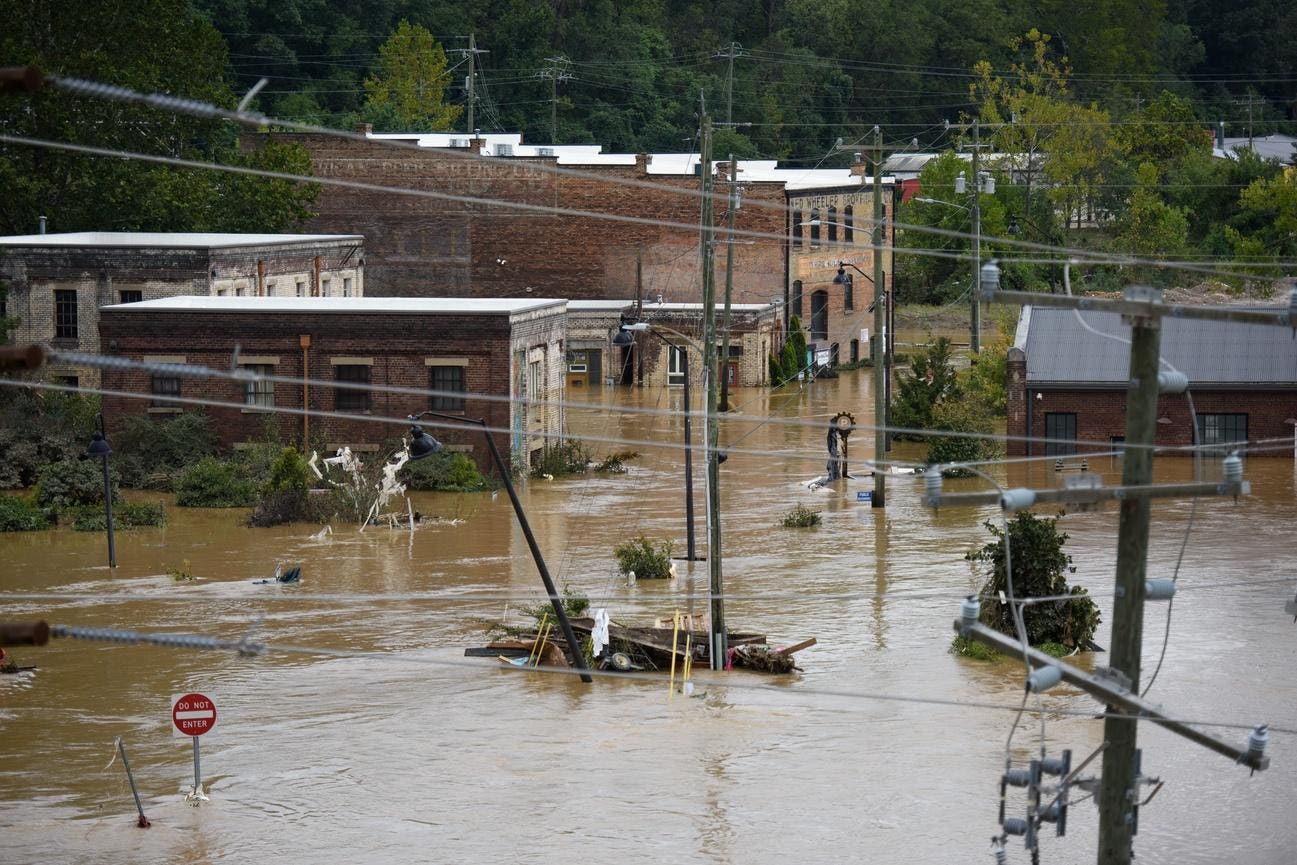About 40 trillion gallons of rain fell from Hurricane Helene. That would fill Dallas … [+]
While storm surges and strong winds are typically considered the most dangerous hazards to life and property during a hurricane, Hurricanes Helene and Milton are stark reminders of additional destructive and potentially life-threatening impacts far from the storm’s core. Inland flooding, as we saw with Helene and Milton with at least 41 tornadoes, highlighted the risk of secondary weather events triggered by these storms. With more than a month left in the official hurricane season, it serves as a reminder that hurricanes can be a threat long before landfall and far from the storm’s center.
Flooding followed by mudslides
Hurricane Helene stretched over 500 miles from Florida to the Southern Appalachians, leaving a path of destruction in its wake. In an interview with The Associated Press, Edward Clark, head of the National Oceanic and Atmospheric Administration’s National Water Center in Tuscaloosa, Alabama, estimated that 40 trillion gallons of rain fell from Helene. This would fill the Dallas Cowboy’s stadium 51,000 times, or the equivalent of 619 days of continuous water flowing over Niagara Falls.
While that number is staggering, it was the crunch time that made it particularly dangerous. August, Georgia got 12 to 15 inches of rain—about four months of rain in just two days. Ashville, North Carolina saw nearly 30 inches of rain in a few days. The intense rain triggered landslides that damaged infrastructure, homes and killed at least 13 of the 250 people who died in Hurricane Helene.
Tornadoes produced by Hurricanes
Hurricanes can also produce large numbers of tornadoes, especially in the outer rainbands. Hurricane Ivan spawned 120 tornadoes in nine states, the most of any tropical storm or hurricane on record in the US
Most tornadoes spawned by tropical storms and hurricanes are rated at the low end of the Enhanced Fujita Scale, a rating based on estimated wind speeds and associated damage. The exceptions are Hurricanes Carla and Hilda with documented F-4 tornadoes from hurricanes moving inland.
Hurricane Milton’s 26 confirmed tornadoes put it in the range of moderate-to-severe tornado outbreaks for a hurricane, especially given that many were particularly strong, with some reaching EF-3 strength.
These tornadoes only compound the extreme weather impacts associated with tropical systems. in the case of Hurricane Milton, at least five people died in St. Louis alone. Lucie County, Florida, contributing to the 17 total deaths reported to date. Tornadoes associated with the storm also contributed to more than 3 million Florida homes and businesses being without power in the storm’s wake.
What causes tornadoes when hurricanes hit
Tornadoes are not uncommon in Florida—the state has more tornadoes per square mile than any other state—but they are usually less destructive than those in the Midwest and Plains. However, tornadoes that occur during hurricanes can be as strong as those found in Tornado Alley because the outer rain bands of hurricanes often contain strong storms of their own and often move very quickly resulting in less advance warning.
Tornadoes resulting from hurricanes and tropical storms most often occur in the front right quadrant of the storm, but they can sometimes occur near the storm’s eyewall. The heat and moisture present in the atmosphere during such storms and the changes in wind direction or speed with height, known as wind shear, contribute to tornado outbreaks.
This was especially evident with Hurricane Milton. The combination of instability in the atmosphere, combined with the fact that Milton spent approximately 24 hours offshore with the warmth of the sun, created the right environment for the tornado to break out away from the hurricane’s center.
Another very significant threat associated with tornadoes produced by tropical systems is the fact that tornadoes form quickly and are often “shrouded in rain”, making it difficult for people to recognize the presence of a tornado until it is too late.
Impact of climate change on hurricanes
Through attribute research, extreme weather events can be directly linked to climate change, such as extreme precipitation and temperature. You can find more information about it in a previous Forbes article I wrote. Recent research has found that climate change may affect tornadoes produced by hurricanes, such as those seen with Milton. The study shows that Milton’s wind speed is likely to be 10% stronger due to the impact of climate change and has contributed to the tornadic activity.
Meteorologists, public entities such as NOAA and the National Hurricane Center, and public officials were diligent and urgent in warning those in the hurricane’s path of the breadth of potential impacts and the danger to life and property. But tornadoes and inland flooding can still catch businesses and the public by surprise, as the focus is often on a hurricane’s coastal implications, such as strong winds and storm surge.
There are always opportunities to improve preparedness for extreme events, and these back-to-back hurricanes are no exception. Making communities more resilient and preparing for what economists Gernot Wagner and Martin Weitzman call “climate shock” will require all stakeholders—from weather experts to response agencies and the public—to understand and respond to compliance with the primary and secondary impacts of extreme weather events.
